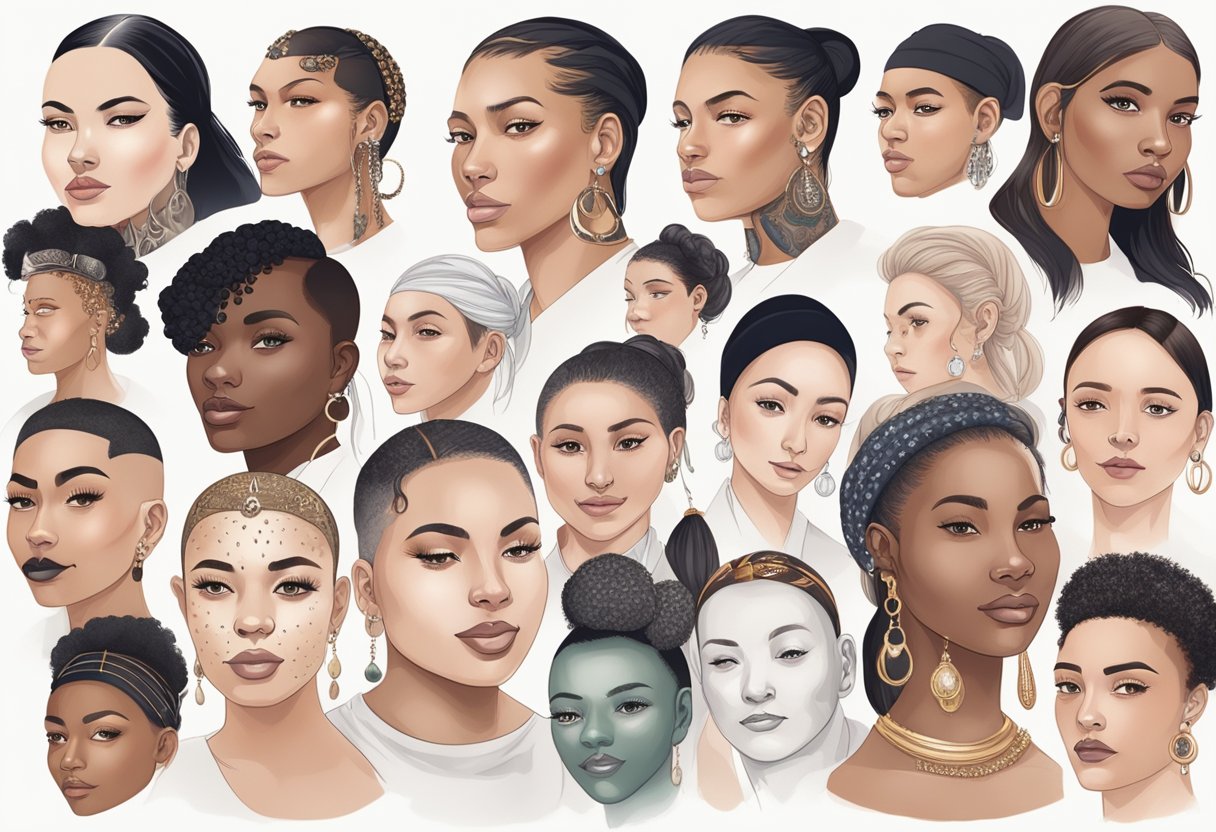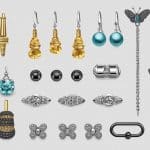Types Of Face Piercings
Facial piercings have been a popular form of self-expression for centuries. They have been worn by different cultures for various reasons, such as religious or social significance. Nowadays, facial piercings are a fashion statement and a way to showcase one’s personality. There are many types of facial piercings, each with its unique style and placement.
The most popular types of facial piercings are nose, eyebrow, lip, and tongue piercings. Nose piercings are the most common and can be done on either side of the nostril or the septum. Eyebrow piercings are usually done vertically above the eye, while lip piercings can be done on either side of the lower or upper lip. Tongue piercings are done in the center of the tongue and can be a bit more complicated than other facial piercings.
When getting a facial piercing, it is essential to consider the type of jewelry that will be used. The most common jewelry options for facial piercings are studs, rings, and barbells. The type of jewelry used will depend on the type of piercing, placement, and personal preference. It is also crucial to choose a professional piercer who is experienced and uses sterile equipment to minimize the risk of infection.
Key Takeaways
- There are various types of facial piercings, including nose, eyebrow, lip, and tongue piercings.
- The type of jewelry used for facial piercings will depend on the type of piercing, placement, and personal preference.
- Choosing a professional piercer and following proper aftercare instructions can help minimize the risk of infection and complications.
Types of Facial Piercings

Facial piercings have become increasingly popular in recent years, with many people opting for unique and expressive ways to adorn their faces. Here are some of the most common types of facial piercings:
Eyebrow Piercings
Eyebrow piercings are a popular choice for those looking to add a bit of edge to their look. This type of piercing involves inserting jewelry through the skin at the eyebrow, typically above or below the eyebrow. The most common jewelry used for eyebrow piercings are curved barbells or captive bead rings.
Nose Piercings
Nose piercings are another popular choice, with several different types to choose from. The most common type is the nostril piercing, which involves inserting jewelry through the skin on either side of the nose. Other popular nose piercings include the septum piercing and the bridge piercing.
Lip Piercings
Lip piercings are a versatile option, with several different types to choose from. The most common type is the labret piercing, which involves inserting jewelry through the center of the lower lip. Other popular lip piercings include the Monroe piercing, which is located on the upper lip, and the medusa piercing, which is located above the upper lip.
Cheek Piercings
Cheek piercings are a unique option, with jewelry inserted through the skin on the cheeks. This type of piercing can be done in several different locations, including the dimples, and can be done on one or both cheeks.
Unique and Less Common Piercings
For those looking for a more unique piercing, there are several options to choose from. The anti-eyebrow piercing involves inserting jewelry just below the eyebrow, while the third eye piercing involves inserting jewelry in the center of the forehead. Other less common piercings include the dolphin bites, canine bites, snakebite, smiley, and frowny piercings.
Overall, facial piercings can be a great way to express oneself and add a bit of individuality to one’s appearance. However, it is important to do research and choose a reputable piercer to ensure that the piercing is done safely and properly.
Jewelry Options for Face Piercings
Face piercings have become increasingly popular in recent years, and with their rise in popularity comes a wider variety of jewelry options to choose from. When it comes to selecting jewelry for a face piercing, there are several factors to consider, including the material, size, and style of the jewelry. In this section, we will explore the different material choices and jewelry types available for face piercings.
Material Choices
The material of the jewelry is an important factor to consider when selecting jewelry for a face piercing. The following are some of the most common material choices for face piercings:
-
Surgical Steel: This is a popular material choice for its durability and resistance to corrosion. It is also hypoallergenic, making it a good choice for those with sensitive skin.
-
Gold: Gold is a popular choice for its aesthetic appeal. However, it is important to note that some people may be allergic to certain types of gold, so it is important to choose a high-quality gold that is free of nickel.
-
Platinum: Platinum is a durable and hypoallergenic material that is also resistant to corrosion.
-
Glass: Glass is a unique material choice that can add a pop of color to your piercing. It is also hypoallergenic and easy to clean.
Jewelry Types
The type of jewelry you choose for your face piercing will depend on the location of the piercing and your personal style. The following are some of the most common jewelry types for face piercings:
-
Barbells: Barbells are a popular choice for tongue piercings and eyebrow piercings. They consist of a straight bar with a ball on each end.
-
Studs: Studs are a classic choice for nose piercings and lip piercings. They consist of a straight post with a decorative top.
-
Curved Barbells: Curved barbells are a popular choice for navel piercings and eyebrow piercings. They consist of a curved bar with a ball on each end.
-
Hoops: Hoops are a versatile jewelry choice that can be worn in a variety of piercings, including nose piercings, lip piercings, and septum piercings.
-
Labret Piercing: A labret piercing is a type of lip piercing that consists of a stud with a flat backing. This type of piercing can be worn with a variety of jewelry styles, including hoops and studs.
-
Lip Ring: A lip ring is a type of jewelry that can be worn in a variety of lip piercings. It consists of a hoop or stud with a decorative top.
-
Septum Rings: Septum rings are a popular choice for septum piercings. They consist of a circular barbell that sits inside the nostrils.
In conclusion, selecting the right jewelry for your face piercing is an important decision that should be made carefully. By considering the material and type of jewelry, you can ensure that your piercing looks great and is comfortable to wear.
Piercing Procedure and Professional Care
Choosing a Professional Piercer
When it comes to getting a facial piercing, choosing a professional piercer is crucial. A professional piercer is someone who has undergone proper training, has experience in performing piercings, and follows the appropriate safety measures. One way to ensure that a piercer is professional is to check if they are a member of the Association of Professional Piercers (APP). The APP is an international organization that sets standards for piercing procedures and provides education and training for piercers.
Piercing Process
The piercing process involves sterilizing the equipment, marking the area to be pierced, and making a perforation or puncture on the skin. Sterilization is a critical step in the piercing process as it helps prevent infections. A professional piercer should use an autoclave to sterilize all the equipment used in the piercing process.
Before making a perforation or puncture, the piercer should mark the area to be pierced using a surgical pen. This helps ensure that the piercing is done in the correct location. The piercer should also use a sterile needle to make the perforation or puncture. After the piercing is complete, the piercer should provide aftercare instructions to the client, which may include cleaning the piercing with saline solution and avoiding certain activities that may cause irritation.
In conclusion, getting a facial piercing requires professional care to ensure the safety and health of the client. Choosing a professional piercer who follows appropriate safety measures and sterilizes equipment is crucial. The piercing process involves marking the area to be pierced and making a perforation or puncture using a sterile needle. Aftercare instructions should be provided to the client to promote healing and prevent infections.
Aftercare and Healing
Taking care of face piercings during the healing process is crucial to prevent infections and promote faster healing. Here are some tips for immediate and long-term aftercare.
Immediate Aftercare
After getting a face piercing, the piercer will provide aftercare instructions. It is important to follow these instructions closely to ensure proper healing. The immediate aftercare includes cleaning the piercing site with saline solution or a gentle soap and water solution twice a day. It is recommended to avoid touching the piercing site with dirty hands and to avoid sleeping on the side of the piercing.
Long-term Care and Maintenance
The healing time for face piercings can vary depending on the type of piercing and the individual’s healing process. Generally, it can take anywhere from 6 to 12 weeks for a face piercing to fully heal. During this time, it is important to continue cleaning the piercing site with saline solution or a gentle soap and water solution twice a day.
Oral hygiene is also important during the healing process. It is recommended to avoid smoking, alcohol, and spicy foods as they can irritate the piercing site. It is also important to brush teeth and tongue regularly and rinse mouth with saline solution after meals.
After the piercing has fully healed, it is important to continue practicing good hygiene and maintenance. This includes regularly cleaning the jewelry and the piercing site, avoiding harsh chemicals and excessive exposure to sunlight, and being cautious when changing jewelry.
By following these aftercare instructions, individuals can ensure proper healing and maintenance of their face piercings.
Risks and Complications
Common Risks
Facial piercings are generally safe when done by a professional piercer who follows proper hygiene and sterilization practices. However, like any body modification, there are risks and complications associated with facial piercings. Some of the common risks include discomfort, rejection, allergic reaction, infection, and scarring.
Discomfort is a common side effect of getting a facial piercing. The process of piercing can cause pain, swelling, and tenderness in the area. These symptoms can usually be managed with over-the-counter pain medication and proper aftercare.
Rejection is another common risk associated with facial piercings. This occurs when the body views the piercing as a foreign object and tries to push it out. Signs of rejection include redness, swelling, and migration of the jewelry. If a piercing is rejected, it will need to be removed to prevent scarring.
Allergic reactions can occur when the body reacts negatively to the metal in the jewelry. Symptoms of an allergic reaction include itching, redness, and swelling. If an allergic reaction occurs, the jewelry will need to be removed and replaced with hypoallergenic material.
Infection is another risk associated with facial piercings. This can occur if proper hygiene and aftercare are not followed. Signs of infection include redness, swelling, discharge, and fever. If an infection occurs, it is important to seek medical attention immediately.
Minimizing Complications
To minimize the risks and complications associated with facial piercings, it is important to choose a professional piercer who follows proper hygiene and sterilization practices. It is also important to follow proper aftercare instructions, which may include cleaning the piercing with saline solution and avoiding touching the piercing with dirty hands.
For oral piercings, it is important to avoid smoking, drinking alcohol, and engaging in oral sex during the healing process to minimize the risk of infection. It is also important to avoid playing with the jewelry or changing it before the piercing has fully healed.
In summary, while facial piercings can be a fun and unique way to express oneself, it is important to be aware of the risks and complications associated with them. By choosing a professional piercer and following proper aftercare instructions, the risks can be minimized and the piercing can heal properly.






